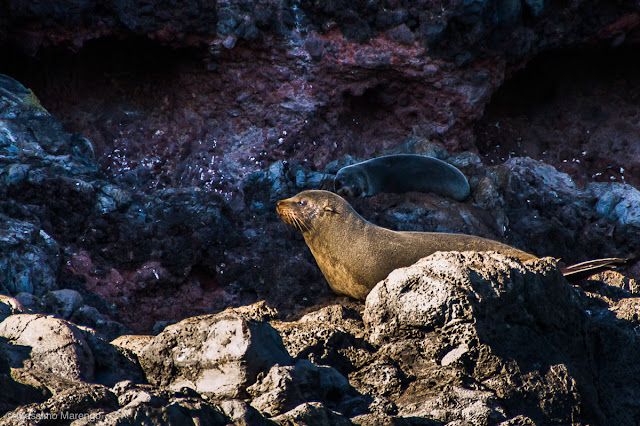 |
| Akaroa Harbor, NZ (May 28, 2008) |
After having seen the penguin, we passed next to a shadowed cliff. We didn’t notice anything particular until we started to hear some weird sounds coming from the rocks. Sounds like somebody was crying... kind of eery. It wasn’t until we covered our eyes from the bright sun and got accustomed watching the darker areas that we saw them. The rocks were full of large, noisy seals that were lazing out the hottest hours of the day (not very hot, actually, it was winter after all) resting at the base of the cliffs. The photo was difficult to take. The cliffs were in the shadow, and I was limited in how much I could expose because the boat was moving quite a lot. Even after opening everything I could, most of the photos still came out blurred. In the end I think this one works, and the one at the bottom, even though I am quite surprised by the color of the rocks in the background. They weren’t looking so red; I am wondering if it is a question of color correction, or this is their natural color...
 |
| Splash! |
The one on the left is probably my favorite photo from Akaroa. The sea was rather calm in the harbor, and also in the Pacific Ocean outside. However, these rocks were right at the mouth of the harbor and the currents were playing some weird game creating these huge sprays. So I just waited a little until I got this single shot before the boat was moving out of range. I guess I got lucky, but I like how the veil of water at the bottom of the wave is so dark and thick that hides the sea and the rocks behind, providing a strong contrast with the crown of clear white spray. I just like how the blues and the whites mix well... and how the spray is so sharp (there was enough light around that I could really use a very short exposure). This was just when we were moving out of the harbor to sea the high volcanic cliffs (Akaroa was formed by the collapsed crater of a huge ancient volcano), and just before we got another surprise... but I will let this for the next post...
 |
| Akaroa Harbor, NZ (May 28, 2008) |


















